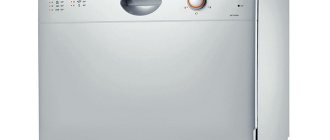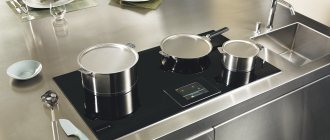A well-equipped kitchen is one of the main components for a comfortable stay for residents of an apartment or house. Tasty and healthy food not only helps maintain good health, but also improves a person’s emotional state. And the quality of dishes, in turn, depends on the choice of good equipment. And since the main item in the kitchen is always the stove, many housewives have a question about what is better to choose: a dependent or independent hob. The answer to this question can be easily obtained by studying the types of cookstoves, their design differences and operating features.
Main types of hobs
When choosing a hob, you need to take into account several more design features. All plates differ from each other in the type of heating elements.
Modern kitchen stoves are:
- electrical;
- gas;
- combined.
The choice of a particular model directly depends on whether gas is supplied to the room, or whether the owners use only electricity. If in the latter case the choice is obvious, then the presence of gas in the house makes you think about the advantages and disadvantages of all three types of panels.
Gas hob
Electric hob
Combination hob
Advice: before buying a new stove or hob for your kitchen, think carefully about which method of cooking will be convenient in your case - gas or electricity.
Gas hobs
The most popular type of slabs. Their main advantage is uniform heating and fast cooking.
A few more advantages of combined gas kitchen surfaces:
- the grille on the panel of gas stoves protects their surface from impacts;
- durable enameled, steel or glass-ceramic coating does not deteriorate from food debris falling on it, as well as exposure to fire and moisture;
- modern models are equipped with a combustion control system - when the flame dies out, the gas is turned off;
- Another feature of the newest gas panels is the ability to use electric ignition.
In the combined version, the hob and oven will have gas burners. Their size, power, as well as number and location may vary depending on the features of a particular model. The standard option is four round burners with a diameter of 60-70 mm, with a power of 2000 watts. Auxiliary burners are usually half the size in both size and power. There are more powerful options - 3500 W for a diameter of up to 100 mm.
Among the disadvantages of this type of slab, one can highlight only the complex connection process, which cannot be dealt with without the help of a specialist.
Attention! Due to incorrect connections or violations during the operation of gas stoves, a gas leak may occur, which is extremely dangerous for the lives of all residents of the house.
Electric cookers
Electric stoves can be installed in any room, and this is their main advantage. Their main design feature is that the heating element is powered by electricity. In this case, two more types of electric stoves can be distinguished:
- The simplest metal tiles with a spiral heater covered with a cast iron “pancake”.
- Glass-ceramic panels with burners hidden under the surface.
Spiral heaters are gradually going out of use, since stoves with them are long-outdated models, which have many more disadvantages than advantages. For example, “pancake” metal tiles are a fire hazard, heat up very slowly (6-10 minutes) and generally look unpresentable.
The type of heating of glass-ceramic hobs can also be different:
- the same as for ordinary electric stoves - spiral;
- tape (or with high-light technology) with faster surface heating;
- with halogen lamps on the burners;
- induction, in which it is not the surface of the stove that is heated, but the bottom of the pan.
Each subsequent type of heating provides faster and better cooking, but is correspondingly more expensive.
Note! For some types of heating elements, you will have to purchase special cookware (for example, for induction panels).
Electric cooktops have many useful features such as automatic shut-off, timer, and touch control lock. The only disadvantage of this type of stove is that if the light goes out, you will have to forget about cooking until the problem is fixed.
Combined hobs
The type of kitchen panels that is rapidly gaining popularity is combined. The essence of the design is to combine two types of heating (gas and electric) on one panel.
In home appliance stores you can find three combinations of electric gas stoves:
- Gas burners on glass ceramics + Hi-Light belt.
- Glass ceramic gas burners + induction hob.
- Metal stove with gas burners and electric coil.
In addition, in dependent stove models you can find a combination of a gas hob and an electric oven.
This option is very convenient because in case of interruptions in the gas pipeline or electricity there is always a backup option. In addition, thanks to different heating features, you can choose the ideal way to prepare any dish.
Tip: having combined kitchen appliances is very convenient in cafes, restaurants, and snack bars. This type of stove allows you to speed up the work of cooking and heating food.
The disadvantage in this case may be the high cost of combined cookers, as well as the need to purchase different dishes for different heating elements.
General information
The technology in question allows housewives to prepare food. Any type of panel looks like a flat base containing heating elements. Heat can be supplied using gas or electricity. But there are also models that involve working from any of these sources. The most popular are units with three to four burners, although some models may have a different number of burners.
What is a dependent hob?
Dependent is a type of stove where the hob is directly connected to the oven. This means that the top of the stove and the oven are connected by a network of wires and plug into the same outlet, having a single control system. All buttons and switches are located on the top of the oven - there are separate controls for the oven and the panel.
Dependent hob
As a rule, a hob and oven in combination are usually purchased to simplify the task of arranging a kitchen. The advantages of such a system:
- The combined option is lower in cost than purchasing a hob and oven separately.
- A dependent kitchen surface is perfect for housewives who often use the oven.
- In this case, it is easier to monitor food preparation on the stove and in the oven at the same time.
- Options for co-dependent panels with ovens are always combined in design, so you don’t have to worry about the organic appearance of the interior.
Thus, dependent hobs are suitable for those who prepare a lot of different dishes and baked goods and do not want to waste time on unnecessary movements around the kitchen. This type of device is also good because in the store you can always choose an option suitable for any interior.
Attention! Before purchasing a hob to be connected to an oven, be sure to check their compatibility. It is best to choose equipment from one manufacturer.
It is worth considering some possible disadvantages of dependent hobs:
- The general control console is not always convenient if only the upper part of the stove is used.
- If one element of the system breaks down, the second also fails, making it impossible to use the stove until the fault is eliminated.
- A low oven position can be dangerous in a home with small children, and can also be inconvenient for older people due to the need to bend over to use it.
It is worth paying attention to the fact that the oven in such a system can be moved away from the top of the tile - for this you will have to lengthen the wires. But this arrangement of the elements of the bundle is rarely chosen, since it is inconvenient to control the burners from a distance.
Comparison
When comparing two options for modern kitchen appliances, important design features come first. They are the key difference between a dependent hob and an independent one. The very names of these devices speak volumes.
Thus, dependent panels are not installed independently, but together with another functional device - an oven. All elements of equipment are controlled from it. It is better to acquire such equipment in full confidence that both the hob and the oven will be used in the future. However, before purchasing, you will need to think about where it would be preferable to put all this.
Meanwhile, the independent panel works on its own, and the entire control system is located in it. Naturally, this one unit takes up much less space and is easier to place in the kitchen. In addition, in this case, you can choose a panel with the most suitable functions for yourself, without thinking about compatibility with any other device.
If you still need an oven, then you should take into account that it and the independent panel purchased separately together will most likely cost more than the “dependent” set. But at the same time, if in the second version of the combination the oven stops working, then the hob will also become unusable. In the case of an independent panel, the breakdown of one device will not affect the functioning of the second.
However, dependent models also have an advantage that should not be discounted. It's about kitchen design. Since in the store such a panel and oven are most often already bundled together, they match each other in terms of design, which means they will look harmonious in the kitchen. An oven (if one is needed) still needs to be selected for an independent surface.
So, knowing the difference between a dependent and an independent hob, you can make your choice. This useful acquisition will be indispensable in preparing dishes.
Benefits of installing an independent hob
The peculiarity of an autonomous hob can be understood based on its name - it functions completely independently. The control center for the burners in this case is located in a specially designated place directly on the panel. The oven can be connected separately if necessary.
Independent hob
Despite the higher cost, this type of slab is popular due to some advantages:
- By separating the oven from the top of the stove, there are more options for planning your kitchen space.
- Many models have built-in touch control buttons, which make using the stove faster.
- Another advantage of the touch control system is that it is much easier to wash a completely flat surface.
- The range of independent hobs with varied functionality is much wider than their dependent counterparts.
- You can purchase equipment from different manufacturers, since it connects to different outlets and does not require compatibility.
- This option is ideal for those who rarely use the oven or have abandoned it completely.
If the main thing for you when arranging your kitchen is ergonomics and minimalism, the option of free-standing tiles and oven is ideal for you.
Tip: in addition to the convenient location of the panel itself, you can experiment with installing the oven. Often it is not installed among the cabinets standing on the floor, but raised higher, to a level that is convenient for use by adults and safe for children.
There is also an opportunity to save money in this case: if you rarely cook at home, you can purchase a small two-burner model, which will cost much less, and at the same time refuse to buy an oven for it.
What is the difference?
It is not difficult to understand the difference between a dependent hob and an independent one. “Dependency” involves connecting the hob with the oven using a common drive. This means that the two devices cannot be operated separately. They have common electrical cables and a single control unit. The connection diagram for dependent appliances implies that the oven will be located under the panel and nothing else.
Independent devices operate autonomously. They are not “connected” by common wires and have their own control units. Such equipment can be arranged in a way that is convenient for the owner. The autonomous panel cuts into the countertop of the kitchen unit, and the oven is located in any area of the work area.
By choosing an independent panel, you can avoid purchasing an oven altogether. This is an ideal option if household members do not “favor” baked goods and other dishes prepared in the oven.
If necessary, you can choose a built-in hob of any type - gas, electric, induction or combined.
Tips for choosing a hob for the kitchen
So, in order to finally decide on the choice of hob model, think about some of the nuances of their use and kitchen layout:
- built-in appliances must ideally fit the size of the kitchen unit. The smallest one- or two-burner tiles are 30 cm wide and 40 mm thick, and the largest can accommodate up to 8 burners;
- think about rational use of kitchen space. What will be more convenient: keep the oven at the bottom of the set or raise it to eye level?
- You shouldn’t shell out money for expensive equipment if you won’t use it often;
- in the opposite situation, when the housewife wants to spend time cooking with pleasure and comfort, it will be more rational to purchase all the elements of the bundle at once;
- the range of autonomous stoves allows you to choose models with a built-in deep fryer, grill or barbecue - the possibilities for preparing a variety of food in this case are much wider;
- If you pay great attention to the harmonious combination of all kitchen interior items, it is better to think about purchasing a related set. In this case, the chance of finding the perfect stylized hob with oven is much higher.
Dependent hob
Independent hob
In general, you need to choose between a dependent and independent hob for the kitchen based on your goals. If you are a fan of simple food without culinary delights, an ordinary autonomous panel will be enough. If you like to have friends and family over at your place, treating them to culinary masterpieces of your own making, you should think about buying a more “sophisticated” stove model.
Watch a video on how to choose a hob
Advantages and disadvantages of dependent plates
The design, in which the oven and hob form a single module, leaves no chance for further rearrangements: the position of the oven is not subject to appeal, and it will not be able to move to a separate place, no matter how much the owner wants it. On the other hand, if food is prepared simultaneously “from below” and “from above”, the processes will be easier and faster to control, since both the appliances themselves and their switches are close to each other (you must admit that it is not always convenient to run to the other end of the kitchen every minute and not everyone).
Pros:
Minuses:
Methods for connecting ovens
Nowadays, the choice of ovens is very large. They are divided into several types:
- Electrical. In these kitchen aids, food is cooked using infrared radiation, and the oven receives power, as the name implies, from the electrical network. Such devices provide a wide variety of cooking programs. And thanks to their high power, food cooks much faster.
- Gas. They run on blue fuel and have burners installed in the lower part. Connection to the gas pipe is made using a special hose with nuts at the ends. There are also gas ovens with an electric grill - in this case, an electrical connection is also required.
We come to a decision
If you are not too keen on oven cooking and only use the oven occasionally, it makes sense to choose an independent model. Such a stove allows you to use space more rationally: the hob will be compactly built into the countertop (all kinds of kitchen utensils will take up the empty space under it), and the oven will fit well in a corner set or a high cabinet - at the hostess’s eye level. It is also convenient that in this case there is no need to worry about the compatibility of the equipment - the devices are in no way connected with each other, which means they have the right to belong to different companies.
How to choose?
When choosing between dependent and independent hobs - which is better - each buyer determines for himself individually. This depends on the need to use the panel and the equipment already built into the kitchen. If the kitchen already has an oven, it is best to choose an independent surface option.
When choosing a panel, you must also select specific functions. Thus, dependent and independent hobs can be conventional, designed for grilling or barbecuing, and also equipped with a deep fryer.
It is very important to choose furniture for installing hobs. Not all kitchen units allow the installation of cooking appliances. The dimensions of the cooking surfaces should also be calculated depending on the size of the countertops.
Popular models and prices
The leader in the production of equipment for home kitchens, Bosch, offers the HBB43C350 for approximately 37.8 thousand rubles. with this functionality:
You may also be interested in information about what kind of lighting there is for the kitchen under cabinets.
Gorenje products, model BO 635E11BK-2, are distinguished by the following characteristics:
Timer and fan to cool the door.
But what the independent electric oven Bosch hba23b263e looks like and how it is installed and used is detailed here.
The well-known company Electrolux offers the OPEA brand with the following functionality:
Presence of a timer, electric probe grill.
But what is best to choose and use, a gas oven or an electric one, and also what reviews there are about this or that device.
Products from the Fornelli company model FGA 45 worth 26.2 thousand rubles:
There is a backlight, a timer and automatic cleaning.
We offer for review the ZOG511217C model from the Zanussi company worth up to 40 thousand rubles:
Backlighting and automatic shutdown of the device at the end of the set timer.
Gefest products brand EDV DA 602-01 K costing up to 9.8 thousand rubles:
You may also be interested in information on how to connect a hob and oven.
As you can see, the range of prices does not mean at all that the oven will cook almost by itself: you need to set the operating mode everywhere and run auto-cleaning, or wash the oven yourself in the best traditions of our grandmothers.
We hope that our recommendations will help you make the right choice.
Planning the space
1. First the kitchen, then the appliances!
One of the biggest mistakes buyers make is to take all the appliances first and only then order a kitchen plan. Thus, you become dependent on the dimensions of the purchased devices and can no longer experiment with the layout of the headset.
If you have never encountered built-in appliances before, preliminary consultation with furniture makers or appliance sellers is required! The fact is that different sizes of cabinets and pencil cases require different equipment. And if you take a 60-centimeter oven under a 60-centimeter cabinet, it simply will not fit there.
This is especially true for such specialized appliances with floating sizes, such as a washing machine, coffee makers, microwave ovens, and so on. You can choose appliances, but it’s better to buy them after creating the kitchen design.
2. You shouldn’t buy appliances from a kitchen showroom.
In many furniture stores, customers are offered to immediately select appliances when ordering a kitchen set. But it often turns out to be much more expensive than if you go to a specialized hardware store. In addition, there is a chance that they will sell you what is profitable for the sellers, or only those brands that they have and which they understand. In hardware stores, there is usually more choice, and the consultants themselves are more qualified, since they specialize only in technology.
Among other things, it is not always clear how a furniture showroom will provide warranty service if necessary. Do they have established partnerships with suppliers, connections with service centers and the ability to provide you with timely and quality assistance?
3. We move the sockets to the side
In general, it is best to have a kitchen showroom help you with the electrical layout before it is carried out. But if this is impossible for one reason or another, remember the basic rule: sockets cannot be located immediately behind the technical device. Otherwise, you will have to move the entire kitchen unit forward. Neither ovens, nor refrigerators or other appliances have enough space to accommodate a socket and ensure the correct and safe position of the plug.
Ideally, sockets are placed under cabinets at a distance of about 10 centimeters from the floor (under the kitchen plinth) or away from the appliance.
4. Built-in appliances are easier to update
Firstly, you do not depend on the manufacturer when choosing. No one will forbid you to take an oven from one brand and a hob from another. In addition, you don’t have to make compromises when, for example, you are completely satisfied with some parameters in a solid stove, but would like a larger oven. It is easier to change and repair built-in equipment, because everything goes separately.
Specifications
Now I want to present a number of technical characteristics declared by the manufacturer for each review model.
| Brand | Hansa BHI68300 | Bosch PIC645F17E | Bosch PIB651F17 E | Electrolux EHH 56240 IK | Samsung CTR432NB02 |
| GENERAL CHARACTERISTICS | |||||
| Panel type | Electric hob | Electric hob | Electric hob | Electric hob | Electric hob |
| Domino design | No | No | No | No | Yes |
| Installation | Independent | Independent | Independent | Independent | Independent |
| Dimensions (w*d) | 60*51 cm | 58.4*51.4 cm | 59.2*52.2 cm | 59*52 cm | 28.8*50.5 |
| Installation dimensions | 58*48.5 cm | 56*49 cm | 56*49 cm | 56*49 cm | 27.3*49 cm |
| Rated power | 7 kW | 7.2 kW | 7.2 kW | 6.6 kW | 3 kW |
| BURNERS | |||||
| Panel material | Glass ceramics | Glass ceramics | Glass ceramics | Glass ceramics | Glass ceramics |
| Total burners | 4 | 4 | 4 | 4 | 2 |
| Burner type | 4 induction | 2 induction 2 ceramic | 4 induction | 4 induction | 2 HiLight ceramics |
| Burner with oval heating zone | 0 | 1 | 1 | 0 | 0 |
| CONTROL PANEL | |||||
| Panel location | Front | Front | Front | Front | Front |
| Switches | Sensory | Sensory | Sensory | Sensory | Sensory |
| PECULIARITIES | |||||
| Additional functions | Burner timer Panel lock button Residual heat indicator Safety shutdown | Burner timer Panel lock button Residual heat indicator Safety shutdown Automatic dish recognition | Burner timer Panel lock button Residual heat indicator Safety shutdown Automatic dish recognition | Panel lock button Residual heat indicator Safety shutdown | Burner timer Panel lock button Residual heat indicator Safety shutdown |
| Color | Black | Black | Black | Black | Black |
| Price | From 16 tr. | From 28 tr. | From 38 tr. | From 19.9 tr. | From 13 tr. |
Now we will evaluate the practical significance of the technical characteristics.











